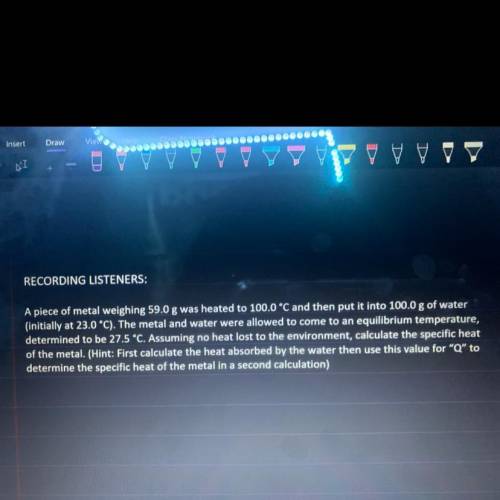
Chemistry, 17.12.2021 05:30 chasechevy13
A piece of metal weighing 59.0 g was heated to 100 C and then put into 100.0 g of water (initially at 23.0 C) the metal and water were allowed to come to an equilibrium temperature, determined to be 27.5 C. Assuming no heat lost to the environment, calculate the specific heat of the metal.


Answers: 1
Another question on Chemistry

Chemistry, 22.06.2019 05:30
Which of the following two events occur to create a sea breeze? select all that apply. warm air rises on the ocean and moves toward the land to cool warm air rises on land and moves toward the ocean to cool cool air moves from the ocean to be warmed by the land cool air moves from the land to be warmed by the ocean
Answers: 3

Chemistry, 22.06.2019 06:00
This flow chart shows the amount of energy that is emitted by each type of light. ultraviolet > blue light > yellow light > red light (maximum energy) (minimum energy) in an experiment, shining which type of light on a strip of metal would be least likely to produce the photoelectric effect? ultraviolet light dim blue light bright red light bright yellow light
Answers: 2

Chemistry, 22.06.2019 17:50
You exhale co2 which is produced during cellular respiration. co2 combines with the water in your blood's plasma to make up one half of the body's most important buffer pair, carbonic acid. the more physical activity you engage in, the more co2 your body is producing. you can see this by putting some of the cabbage indicator in a glass and then blowing bubbles into it through a straw. can you see a change in the color of the indicator?
Answers: 2

Chemistry, 22.06.2019 20:20
The characteristics of two different types of reactions are shown below: reaction a: electrons are gained by the atoms of an element. reaction b: protons are lost by the atom of an element. which statement is true about the atoms of the elements that participate in the two reactions? their identity changes in both reaction a and reaction b. their identity changes in reaction a but not in reaction b. their identity changes in reaction b but not in reaction a. their identity remains the same in both reaction a and reaction b.
Answers: 1
You know the right answer?
A piece of metal weighing 59.0 g was heated to 100 C and then put into 100.0 g of water (initially a...
Questions

Mathematics, 02.12.2020 05:40






History, 02.12.2020 05:40


Physics, 02.12.2020 05:40


Mathematics, 02.12.2020 05:40


Geography, 02.12.2020 05:40


Mathematics, 02.12.2020 05:40

Biology, 02.12.2020 05:40

History, 02.12.2020 05:40

Mathematics, 02.12.2020 05:40

Mathematics, 02.12.2020 05:40




